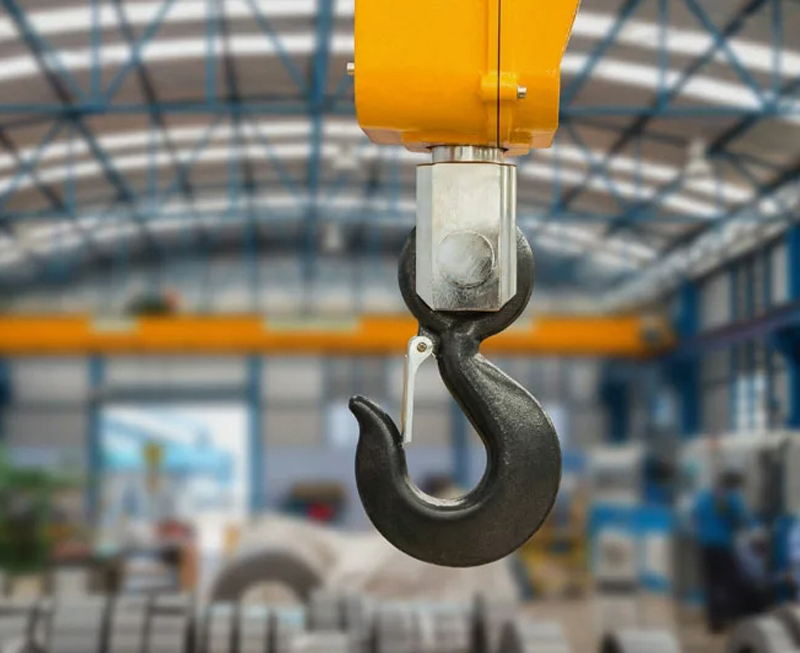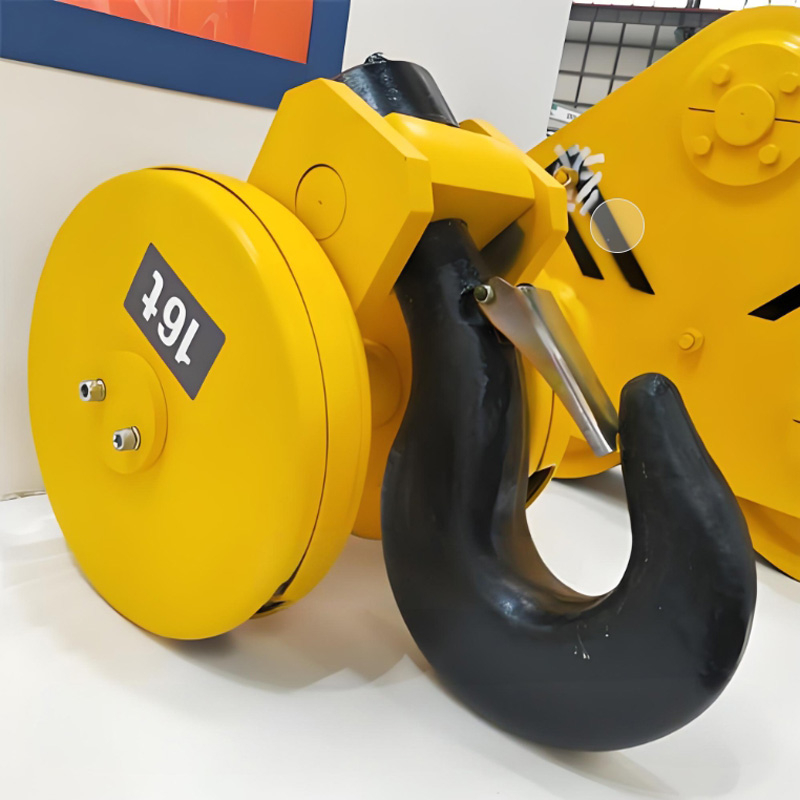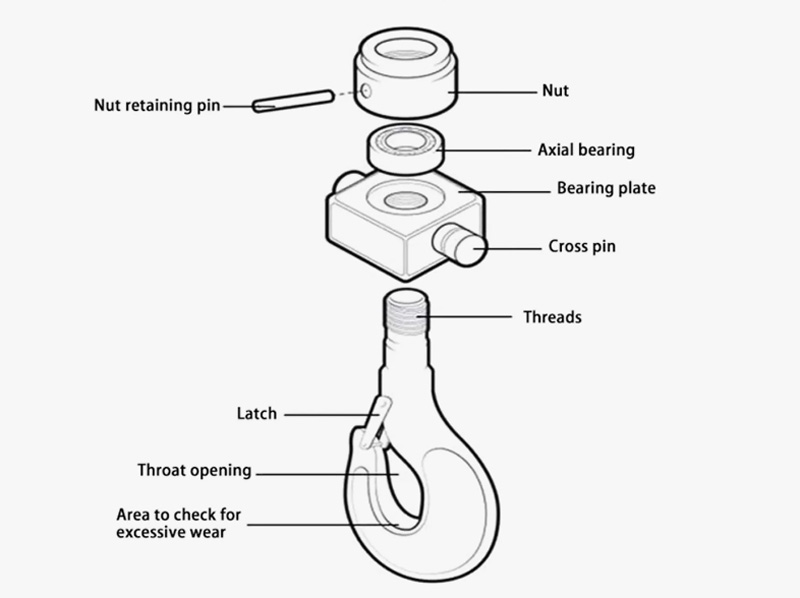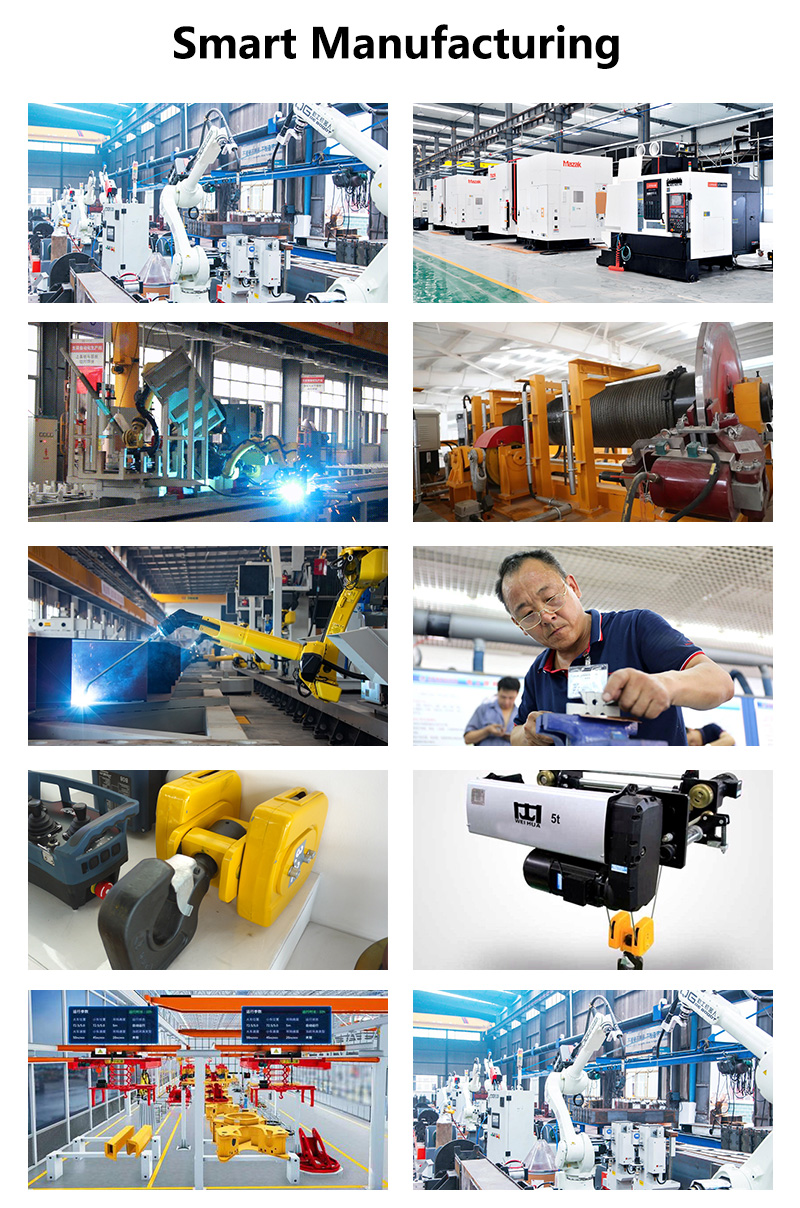겸손 크레인 후크 안전 래치 중요합니다, 그러나 종종 간과되었습니다, 리프팅 작업의 구성 요소. 그것은 치명적인 부하 분리에 대한 마지막 방어선 역할을합니다.. 그러나 단순히 래치를 갖는 것은 충분하지 않습니다. 필요할 때 안정적으로 작동하려면 엄격한 요구 사항을 충족해야합니다.. 이러한 요구 사항을 이해하는 것이 안전에 가장 중요합니다, 규정 준수, 사고 방지.
시나리오를 상상해보십시오: 하중이 예기치 않게 스윙합니다, 장애물을 부딪칩니다, 또는 들어 올리는 동안 기울입니다. 기능적 안전 걸쇠없이, 슬링이나 체인은 후크의 팁에서 쉽게 미끄러질 수 있습니다., 수많은 재료 급락. 안전 걸쇠는 후크 목구멍 개구부를 물리적으로 차단합니다, 그러한 우발적 석방을 방지합니다. 그들의 중요성은 과장 될 수 없습니다.

표준 준수 (기초):
ASME B30.10 (후크): 이것은 미국의 주요 표준 관리 후크와 안전 속담입니다.. 로드 리프팅 응용 프로그램에 사용 된 후크를 의무화합니다 ~ 해야 하다 우발적 인 하중 분리를 방지하기위한 래치 또는 기타 효과적인 수단을 장착하십시오., ~하지 않는 한 응용 프로그램은 래치를 실용적으로 만들거나 동등한 안전성을 제공합니다. (엄격한 정당화가 필요한 드문 예외).
OSHA 규정 (29 CFR 1910.179 & 1926.550): OSHA 규정은 ASME 표준을 통합하고 시행합니다. 그들은 안전 걸쇠를 갖기 위해 고리가 필요합니다, 래치가 작동하지 않는 Choker Hitch Rigging에 Grab Hook를 사용하는 것과 같은 특정 상황을 제외하고, 또는 전용 파운드리 후크. 예외가 적용되는 문서화가 중요합니다.
다른 지역 표준 (예를 들어, 안에 1677, ISO 2415): 전 세계적으로 유사한 엄격한 요구 사항이 존재합니다. 장비는 운영 영역에 적용 가능한 표준을 준수해야합니다..
강력한 디자인 및 구성:
재료: 래치는 고품질로 만들어야합니다, 단조 합금강과 같은 내구성있는 재료, 영향을 견딜 수 있습니다, 연마, 그리고 환경 조건 (수분, 약, 극한의 온도) 작업장의.
힘: 래치는 우연히 부하 또는 충격 아래에서 열려고 노력하는 힘에 저항 할만 큼 강해야합니다.. ASME B30.10은 후크의 전체 정격 하중을지지하기 위해 걸쇠가 필요합니다. 영구적 인 변형없이 부하가 직접적으로 부담해야한다면 (이것은 의도 된 로딩 시나리오는 아니지만).
긍정적 인 참여: 래치는 닫아야합니다 잠그다 후크 팁 위에 단단히. 중력이나 마찰에만 의존하는 것은 충분하지 않습니다. 스프링로드 래치가 일반적입니다, 그러나 봄은 흙을 극복 할만 큼 강력해야합니다., 경미한 변형, 또는 페인트 축적. 래치 설계는 잔해물이 메커니즘을 막을 수있는 지점을 최소화해야합니다..
전체 커버리지: 래치는 후크 목구멍 개구부를 효과적으로 덮어야합니다 ("입을 크게 벌리다") 닫을 때, 리깅이 미끄러질 수있는 큰 간격을 남기지 않습니다.
기능 및 작동:
수동 작동 (필요한 경우): 래치는 쉽게 설계해야합니다, 안전한, 운영자의 의도적 수동 작동 (종종 래치 핀이나 핸들과 같은 도구를 사용합니다.). 그들은해야합니다 ~ 아니다 부딪 치거나 걸어 실수로 쉽게 열 수 있습니다.
자체 폐쇄/양수 잠금: 이상적인 래치는 자체 폐쇄 및 자체 잠금입니다. 후크 안장에 하중이 앉으면, 래치는 운영자 개입없이 자동으로 닫히고 위치에 고정해야합니다.. 이를 통해 리깅 후 보호가 항상 제자리에 있도록합니다.
방해받지 않는 움직임: 래치는 바인딩없이 힌지 핀에 자유롭게 피벗해야합니다.. 힌지 핀은 안전해야합니다 (예를 들어, 리벳, 코터 핀) 우발적 인 분해를 방지합니다. 스프링은 긴장을 유지해야합니다.
검사 및 유지 보수 요구 사항:
정기적 인 육안 검사: 래치는 매일 또는 각 사용 전에 검사해야합니다 (OSHA/ASME 당) 마모의 징후, 왜곡, 균열, 부식, 깨진 스프링, 그리고 자유 운동. 구부러진 모든 걸쇠, 완전히 닫히지 않습니다, 막대기, 또는 그렇지 않으면 결함이있는 경우 즉시 서비스에서 제거해야합니다..
주기적으로 철저한 검사: 자격을 갖춘 사람의 포괄적 인 검사, 후크 제조업체 및 ASME B30.10 일정에 따라, 필수입니다. 여기에는 피벗 포인트에서 마모 확인이 포함됩니다, 봄 긴장, 그리고 구조적 무결성.
매끄럽게 하기: 원활한 작동을 보장하고 압수를 방지하기 위해 제조업체의 권장 사항에 따라 래치를 윤활해야합니다., 특히 가혹한 환경에서.
수정이 없습니다: 안전 걸쇠는 용접해서는 안됩니다, 굽은, 또는 후크 제조업체가 명시 적으로 승인하지 않는 한 달리 수정되었습니다.. 수정은 강도와 기능을 손상시킬 수 있습니다.
호환성:
래치는 특정 제조업체와 함께 사용하기 위해 특별히 설계 및 인증을 받아야합니다., 모델, 그리고 크레인 후크 설치되어 있습니다. 부정확하거나 비 OEM 래치 사용은 매우 위험하며 무효 인증.

스프링로드 (앞뒤로 흔들리는) 걸쇠: 가장 일반적인 유형. 강한 스프링으로 후크 팁 위로 닫힌 피벗 래치. 리깅 배치를 허용하기 위해 바깥쪽으로 열립니다. 자체 클로즈와 잠금해야합니다.
접는 걸쇠 (훅-훅): 열면 고리 생크에 평평하게 접습니다, 닫을 때 팁을 덮기 위해 피벗됩니다. 종종 포지티브 잠금을 위해 스프링로드 핀을 사용합니다.
회전 (카메론) 걸쇠: 가로 질러 미끄러지는 회전 막대 크레인 후크 목구멍 개구부. 수동 회전이 개방/닫기 위해 필요하지만 매우 긍정적 인 적용 범위를 제공합니다.. 더 큰 후크에서 일반적입니다.
치명적인 부하가 떨어집니다: 가장 심각한 위험, 잠재적 인 사망자로 이어집니다, 심각한 부상, 그리고 대규모 재산 피해.
규제 벌금 및 인용: 부족한 안전 걸쇠와 관련된 OSHA 위반은 상당한 처벌을받습니다..
가동 중지 시간 및 수리 비용: 사고는 운영 중단 및 비용이 많이 드는 수리가 발생합니다.
책임: 회사와 개인은 심각한 법적 책임에 직면 할 수 있습니다.



에이 크레인 후크 안전 래치 금속 조각이 아닙니다; 엄격한 요구 사항에 따라 중요한 안전 장치입니다. ASME/OSHA 표준 준수, 긍정적 인 잠금과 힘을 보장하는 강력한 구조, 엄격한 검사 및 유지 보수 루틴, 그리고 특정 후크의 올바른 걸쇠를 사용하는 것은 절대적인 필수품입니다.. 래치 무결성을 절대 타협하지 마십시오. 모든 검사를 진지하게 취급하십시오, 손상된 래치를 즉시 교체하십시오, 운영자가 중요한 기능을 이해하도록합니다. 올바르게 작동하는 크레인 후크 안전 레이치는 작업장과 직원을 안전하게 유지하는 데 엄청난 역할을하는 작은 구성 요소입니다.. 기억하다, 들어 올릴 때, 래치는 마지막 방어선입니다. 전투 준비가되어 있는지 확인하십시오..
우리는 귀하의 의견을 소중히 여깁니다! 귀하의 특정 요구에 맞게 서비스를 조정할 수 있도록 아래 양식을 작성하십시오..

최신 의견